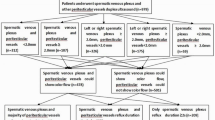Abstract
Purpose
The purpose of this study is to determine the prevalence of left renal vein compression in patients with varicoceles.
Methods
Abdominal and pelvis contrast-enhanced CT images from 100 male patients with varicoceles (mean age 50.6 years) and 100 matched control patients (mean age 49.8 years) were retrospectively reviewed. The diameter of the left renal vein was measured as it crosses between the aorta and superior mesenteric artery and was classified as compressed if there was greater than 50% narrowing. The diameter of the left gonadal vein was measured at the origin. Comparison of the prevalence of left renal vein compression was made via a Chi-squared test and the gonadal vein diameter via a t test.
Results
The distribution of varicoceles was 68 on the left, 24 bilateral, and 8 on the right. Compression of the left renal vein was significantly more common in the left varicocele (78%, 53/68) than in the bilateral varicocele (42%, 10/24, p = 0.002), right varicocele (13%, 1/8, p < 0.001), or control group (10%, 10/100, p < 0.001). In the subgroup analysis, the gonadal vein diameter was significantly greater in the left varicocele (mean 5.6 mm) than in the bilateral varicocele (mean 4.6 mm, p = 0.018), right varicocele (mean 3.2 mm, p < 0.001), and control group (mean 3.1 mm, p < 0.001).
Conclusion
Left renal vein compression by the superior mesenteric artery is a major contributor to left-sided varicoceles.



Similar content being viewed by others
References
World Health Organization (1992) The influence of varicocele on parameters of fertility in a large group of men presenting to infertility clinics. Fertil Steril 57:1289–1293
Sandlow J (2004) Pathogenesis and treatment of varicoceles. Bmj 328:967–968.
Skoog SJ, Roberts KP, Goldstein M, Pryor JL (1997) The adolescent varicocele: what’s new with an old problem in young patients? Pediatrics 100:112–121.
Fretz PC, Sandlow JI (2002) Varicocele: current concepts in pathophysiology, diagnosis, and treatment. Urol Clin North Am 29:921–937.
Richardson I, Grotas AB, Nagler HM (2008) Outcomes of varicocelectomy treatment: an updated critical analysis. Urol Clin North Am 35:191–209 ((viii)).
Wishahi MM (1991) Anatomy of the venous drainage of the human testis: testicular vein cast, microdissection and radiographic demonstration. A new anatomical concept. Eur Urol 20:154–160.
Chait A, Matasar KW, Fabian CE, Mellins HZ (1971) Vascular impressions on the ureters. Am J Roentgenol Radium Ther Nucl Med 111:729–749.
Ahlberg NE, Bartley O, Chidekel N, Fritjofsson A (1966) Phlebography in varicocele scroti. Acta Radiol Diagn (Stockh) 4:517–528
Braedel HU, Steffens J, Ziegler M, Polsky MS, Platt ML (1994) A possible ontogenic etiology for idiopathic left varicocele. J Urol 151:62–66.
Shafik A, Moftah A, Olfat S, Mohi-el-Din M, el-Sayed A (1990) Testicular veins: anatomy and role in varicocelogenesis and other pathologic conditions. Urology 35:175–182.
Grimm LJ, Engstrom BI, Nelson RC, Kim CY (2013) Incidental detection of nutcracker phenomenon on multidetector CT in an asymptomatic population: prevalence and associated findings. J Comput Assist Tomogr 37:415–418.
Kurklinsky AK, Rooke TW (2010) Nutcracker phenomenon and nutcracker syndrome. Mayo Clin Proc 85:552–559.
Liebl R (2009) Nutcracker phenomenon or nutcracker syndrome? Nephrol Dial Transpl 20 (author reply 2009. Epub 2005 Jun 2028).
Buschi AJ, Harrison RB, Norman A, et al. (1980) Distended left renal vein: CT/sonographic normal variant. AJR Am J Roentgenol 135:339–342.
Vassilev I (1962) Radiographic study of the left spermatic vein in the course of idiopathic varicoceles. Press Med 70:704.
Saypol DC, Howards SS, Turner TT, Miller ED Jr. (1981) Influence of surgically induced varicocele on testicular blood flow, temperature, and histology in adult rats and dogs. J Clin Invest 68:39–45.
Zerhouni EA, Siegelman SS, Walsh PC, White RI (1980) Elevated pressure in the left renal vein in patients with varicocele: preliminary observations. J Urol 123:512–513.
Eliahou R, Sosna J, Bloom AI (2012) Between a rock and a hard place: clinical and imaging features of vascular compression syndromes. Radiographics 32:E33–E49.
Wheeler EC, Brenner ZR (1995) Peripheral vascular anatomy, physiology, and pathophysiology. AACN Clin Issues 6:505–514.
i Cuellar CH, Gomez SQ, Cerqueda CS, de la Presa RB, Miranda A (2005) Alvarez-Castells A (2005) Nutcracker or left renal vein compression phenomenon: multidetector computed tomography findings and clinical significance. Eur Radiol 15:1745–1751.
Cope C, Isard HJ (1969) Left renal vein entrapment. A new diagnostic finding in retroperitoneal disease. Radiology 92:867–872.
Lee CT, Katz J, Fearn PA, Russo P (2002) Mode of presentation of renal cell carcinoma provides prognostic information. Urol Oncol 7:135–140.
Roy CR 2nd, Wilson T, Raife M, Horne D (1989) Varicocele as the presenting sign of an abdominal mass. J Urol 141:597–599.
Cheungpasitporn W, Horne JM, Howarth CB (2011) Adrenocortical carcinoma presenting as varicocele and renal vein thrombosis: a case report. J Med Case Rep 5:337.
Brand TC, Morgan TO, Chatham JR, Kennon WG, Schwartz BF (2001) Adrenal cortical carcinoma presenting as right varicocele. J Urol 165:503.
Shinsaka H, Fujimoto N, Matsumoto T (2006) A rare case of right varicocele testis caused by a renal cell carcinoma thrombus in the spermatic vein. Int J Urol 13:844–845.
Disclosures
Doug Lewis: none. Lars Grimm: Advisory Board, Medscape, LLC. Charles Kim: none.
Funding
The authors have grants or funding sources for disclosure.
Author information
Authors and Affiliations
Corresponding author
Rights and permissions
About this article
Cite this article
Lewis, D.S., Grimm, L.J. & Kim, C.Y. Left renal vein compression as cause for varicocele: prevalence and associated findings on contrast-enhanced CT. Abdom Imaging 40, 3147–3151 (2015). https://doi.org/10.1007/s00261-015-0512-y
Published:
Issue Date:
DOI: https://doi.org/10.1007/s00261-015-0512-y




